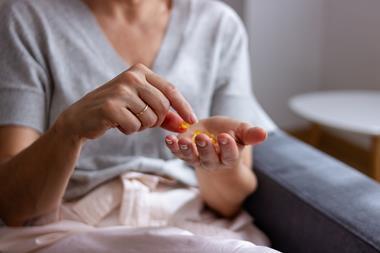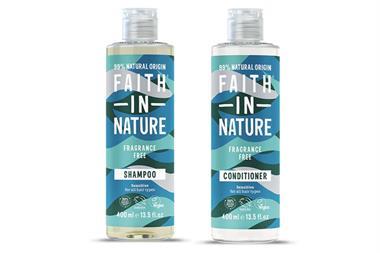Personal care shoppers have long flashed the cash, but will they stop spending now that suppliers have opted to pull the plug on deep discounts? Suzy Bashford reports
The personal care market has reached a tipping point. For years discounts have been diving deeper and deeper, but in 2010 manufacturers decided that enough was enough.
According to SymphonyIRI's director of strategic insight Tim Eales, the year has been a "story of two halves". "Up until April/May 2010 we saw fairly good volume growth, then there was a change in the way products were promoted. At the end of 2009, mid-credit crunch, the level of price cut reached 33 to 34%. It's now 31 to 32%."
Eales predicts that this trend will continue, with suppliers unable to sustain the level and severity of promotions, a trend only exacerbated by the increase in commodity prices, including everything from oil to specialist beauty ingredients such as orange oil, geranium and lavender. The reduction in the depth of price cuts has already hit the £3bn market, which grew by just 1.2% in value in 2010, compared with 3.9% the year before [Kantar 52w/e 20 February 2011].
Volume sales slipped too, growing by just 1.6% in 2010, after a 5.0% increase the previous year, due to lower levels of promotion and consumers tightening the purse strings and buying less, says Tim Nancholas, strategic insight director at Kantar Worldpanel. In this environment, the best performers cited by Eales over the past year are Nivea, Dove and Sure.
But even owner Beiersdorf's senior brand manager, personal care, Stephen Byrne, is acutely aware that Nivea's promotional strategy must adapt. He welcomes the changes: "If you promote and promote there will be no value left. That's not beneficial to anybody. Not even consumers, because it will stop brands investing in NPD. There needs to be some value, so that's why we're starting to do '2 for £4' on our deodorants, for example, rather than '2 for £3.50'. It's a minor move, but it's a move in the right direction," he says.
Of course, this is a category where shoppers are more receptive to experimentation, and a slightly reduced price for a premium product has long been an effective way to lure them to the fixture. The £3bn category question is: how low?
"Personal care consumers are still willing to spend their money on indulgent items. They are prepared to make sacrifices elsewhere in their shopping basket in order to accommodate this," says Matt Close, VP marketing at Unilever.
And if consumers see a genuine, relevant new benefit, or if by luck or marketing judgement, a fashionable, aspirational image is attained, they will pick up and pay for that product.
Numerous launches have managed this since the start of 2010: Sure's 'motionsense' deodorant, which claims to activate in response to body movement; Dove's Men+Care range, which targets "real" men and aims to fill a gap in the market between L'Oreal for Men and Gillette; Clairol's Nice 'n Easy's foam home hair colour range, which claims to make hair colouring easier and less messy; and E45's Endless Moisture body cream, which promises to prolong that "just moisturised" feeling.
It's no coincidence that the brands weathering the economic storm best also top the ad spend league tables. Gillette takes the first and second slots, according to Ebiquity, for Fusion and Venus, spending £9.6m and £5.1m respectively. Heavyweight support for its latest innovation, ProGlide, has helped make the razor category one of the best performing in value sales terms, up 5.4% to £520m [Kantar].
According to Gillette marketing director, P&G, Ian Morley, the ProGlide launch marketing was "unprecedented": "We've deepened our commitment to innovation, and we will always support breakthrough innovations with the right mix of marketing ."
While TV and print remain popular, social media is a growing marketing channel. Lynx, for example, launched its Excite variant with a focus on digital activity, including a Facebook game featuring Kelly Brook. And as Wilkinson's marketing manager Wibke Stoffers points out, newer media, like social networks, are a particularly effective way to reach male buyers. The brand has used QR codes on its PoS material, and found male consumers receptive to pausing instore to access websites and video demos, she claims.
"It's about engaging with them and really finding out how they feel about your brand. They also recommend products to friends. This is more powerful than advertising," Stoffers adds.
While the brands continue to innovate, own label has had a disappointing year, its market share falling by 5.5% to 16.2% [Kantar], thanks to promotions narrowing the price gap and the downturn pushing consumers further towards familiar, established names. The other major barrier to own label is the fact that in a market associated with luxury and treats, a supermarket's name on a product just isn't going to feel treat-like enough.
Sainsbury's, in a bid to address this, has joined forces with luxury spa chain Mandara to develop a range of luxury beauty products, while other retailers sell cleverly positioned tertiary brands, such as Aldi with its Lacura range, including a multi-intensive serum, which is beating Boots products in beauty tests, the retailer claims.
In the face of own label innovations like this, the challenge for manufacturers going forward will be to prove that as the price gap widens again they are worth the extra pennies. This is where NPD is key, and brands that keep innovating will continue to flourish.
Sainsbury's beauty category manager Rhian Bartlett issues a parting plea to brands: "Yes, it's going to become more and more difficult with profit and loss pressures, but brands must continue to invest in newness."
Focus On Personal Care
The personal care market has reached a tipping point. For years discounts have been diving deeper and deeper, but in 2010 manufacturers decided that enough was enough.
According to SymphonyIRI's director of strategic insight Tim Eales, the year has been a "story of two halves". "Up until April/May 2010 we saw fairly good volume growth, then there was a change in the way products were promoted. At the end of 2009, mid-credit crunch, the level of price cut reached 33 to 34%. It's now 31 to 32%."
Eales predicts that this trend will continue, with suppliers unable to sustain the level and severity of promotions, a trend only exacerbated by the increase in commodity prices, including everything from oil to specialist beauty ingredients such as orange oil, geranium and lavender. The reduction in the depth of price cuts has already hit the £3bn market, which grew by just 1.2% in value in 2010, compared with 3.9% the year before [Kantar 52w/e 20 February 2011].
Volume sales slipped too, growing by just 1.6% in 2010, after a 5.0% increase the previous year, due to lower levels of promotion and consumers tightening the purse strings and buying less, says Tim Nancholas, strategic insight director at Kantar Worldpanel. In this environment, the best performers cited by Eales over the past year are Nivea, Dove and Sure.
But even owner Beiersdorf's senior brand manager, personal care, Stephen Byrne, is acutely aware that Nivea's promotional strategy must adapt. He welcomes the changes: "If you promote and promote there will be no value left. That's not beneficial to anybody. Not even consumers, because it will stop brands investing in NPD. There needs to be some value, so that's why we're starting to do '2 for £4' on our deodorants, for example, rather than '2 for £3.50'. It's a minor move, but it's a move in the right direction," he says.
Of course, this is a category where shoppers are more receptive to experimentation, and a slightly reduced price for a premium product has long been an effective way to lure them to the fixture. The £3bn category question is: how low?
"Personal care consumers are still willing to spend their money on indulgent items. They are prepared to make sacrifices elsewhere in their shopping basket in order to accommodate this," says Matt Close, VP marketing at Unilever.
And if consumers see a genuine, relevant new benefit, or if by luck or marketing judgement, a fashionable, aspirational image is attained, they will pick up and pay for that product.
Numerous launches have managed this since the start of 2010: Sure's 'motionsense' deodorant, which claims to activate in response to body movement; Dove's Men+Care range, which targets "real" men and aims to fill a gap in the market between L'Oreal for Men and Gillette; Clairol's Nice 'n Easy's foam home hair colour range, which claims to make hair colouring easier and less messy; and E45's Endless Moisture body cream, which promises to prolong that "just moisturised" feeling.
It's no coincidence that the brands weathering the economic storm best also top the ad spend league tables. Gillette takes the first and second slots, according to Ebiquity, for Fusion and Venus, spending £9.6m and £5.1m respectively. Heavyweight support for its latest innovation, ProGlide, has helped make the razor category one of the best performing in value sales terms, up 5.4% to £520m [Kantar].
According to Gillette marketing director, P&G, Ian Morley, the ProGlide launch marketing was "unprecedented": "We've deepened our commitment to innovation, and we will always support breakthrough innovations with the right mix of marketing ."
While TV and print remain popular, social media is a growing marketing channel. Lynx, for example, launched its Excite variant with a focus on digital activity, including a Facebook game featuring Kelly Brook. And as Wilkinson's marketing manager Wibke Stoffers points out, newer media, like social networks, are a particularly effective way to reach male buyers. The brand has used QR codes on its PoS material, and found male consumers receptive to pausing instore to access websites and video demos, she claims.
"It's about engaging with them and really finding out how they feel about your brand. They also recommend products to friends. This is more powerful than advertising," Stoffers adds.
While the brands continue to innovate, own label has had a disappointing year, its market share falling by 5.5% to 16.2% [Kantar], thanks to promotions narrowing the price gap and the downturn pushing consumers further towards familiar, established names. The other major barrier to own label is the fact that in a market associated with luxury and treats, a supermarket's name on a product just isn't going to feel treat-like enough.
Sainsbury's, in a bid to address this, has joined forces with luxury spa chain Mandara to develop a range of luxury beauty products, while other retailers sell cleverly positioned tertiary brands, such as Aldi with its Lacura range, including a multi-intensive serum, which is beating Boots products in beauty tests, the retailer claims.
In the face of own label innovations like this, the challenge for manufacturers going forward will be to prove that as the price gap widens again they are worth the extra pennies. This is where NPD is key, and brands that keep innovating will continue to flourish.
Sainsbury's beauty category manager Rhian Bartlett issues a parting plea to brands: "Yes, it's going to become more and more difficult with profit and loss pressures, but brands must continue to invest in newness."
Focus On Personal Care







![SHA_0211[1]](https://dmrqkbkq8el9i.cloudfront.net/Pictures/380x253/7/6/9/329769_sha_02111_485851.jpg)
No comments yet